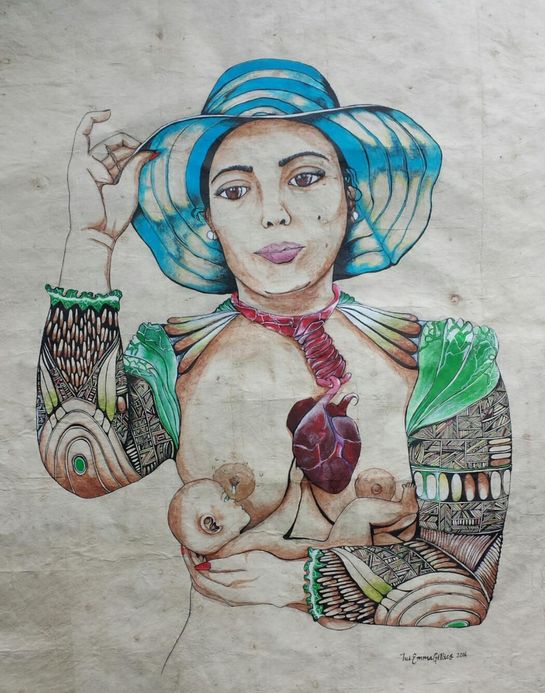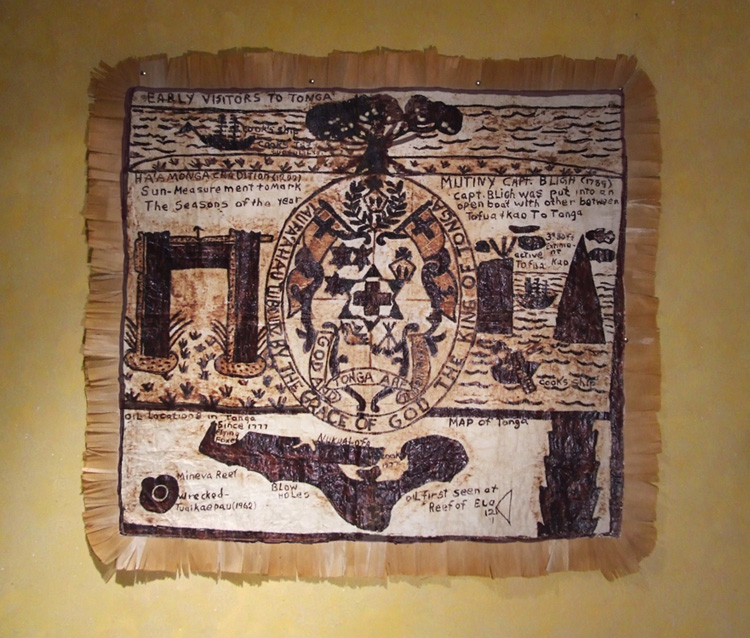BVA History Pacifica Week 1 Term 2
Khan Academy video
One of the issues that was discussed within the video was how indigenous artifacts from cultures are displayed in a museum or gallery. Previously indigenous objects, artifacts and what the moari people call toanga, weren't respected at all in these contexts, such as the case for shrunken heads which began exhibition in 1875 and didn't return to Maori until 2011. Nowadays objects within these contexts are held with a little more respect and regard with many moari and pacifika curators now working and curating within many of these museums that now exhibit toanga. While their are still many controversies surrounding the exhibition of these objects theirs more care and respect given to the object with an attempt to place the object in the way it would be presented in its original environment.
| ‘Siaposu’isu’i’ / VIRGIN Tapa Cloth (2011). Lindah Lepou |
"My creative process starts with an idea, oral tradition, folklore, ancestor, mythology, or historical event linked to my own ‘gafa’ (family lineage), either through my ‘Pacific’ (Samoan) mother or ‘palagi’ (English/Scottish) father. If there is something solid, I use it as an ‘anchor’ to create a stable foundation for the rest of my creative practice to build on."
inspiration behind this garment begins with my personal connection to the first documentary ever made, by the late palagi American director, ‘Robert Flaherty’ called, ‘MOANA of the South Seas’ for Paramount Pictures in 1926. In this film, there is a young fourteen-year-old girl named, ‘Fa’agase’ (Pronounced: Fah-ah-ngah-seh), who is also being filmed in her actual village, Safune, Savai’i, Samoa. But ironically though, she is suspiciously ‘portrayed’ in the film by Robert Flaherty as living in a traditional ‘Samoan way-of-life’ wearing a traditional tapa cloth wrap-skirt, and ‘topless’, despite the fact that during that same time period, the ‘traditional Samoa’, was already being heavily influenced by ‘Palagi’ (caucasian) culture with their religious ideas of dress, ‘to cover everything up’, and fast becoming a ‘western Samoa’. Fa’agase is seen to be in an ancient Fa’a-Samoan cultural and traditional ‘context’ performing a number of traditional Samoan rituals and ceremony. She helps with the making of traditional ‘Siapo’ (Tapa/bark cloth), made from the inner part of mulberry tree bark, that is stripped away and splashed with water as it is continuously folded and beaten with a wooden mallet to soften, and widened into a ‘natural textile’ ready to transform into a traditional costume.
Her ‘character’ also plays ‘the traditional family’, ‘Taupou’ (family maiden) who performs the traditional beverage mixing ritual, called, ‘The Ava Ceremony’, before she performs the traditional ‘Siva’ Samoa (dance). Fa’agase is a ‘symbol’, that reminds us of our ancient traditional fa’asamoa (Samoan way), with noble qualities and attributes like ‘Fa’aaloalo’ (mutual respect), ‘Tautua’ (service), and ‘Alofa’ (love) that make us rich in character and stronger as a unique Pacific identity.
As my late great-grandmother, Fa’agases eldest daughter - my grandmother - is named, ‘Siapo’ (Tapa cloth) (short for our ancient ancestral name, ‘Siaposu’isu’i’). This garment is also worn by Fa’agases great-granddaughter, ‘Brooke’.
I celebrate Fa’agase as an artist, as a Samoan woman and a powerful force that not only lives on in this film, now in the digital space, she continues to live on through this garment preserved in Te Papa for future generations to come." ("UNVEILED Exhibition (2011-2012) • Lindah Lepou", 2019)
 |
| Fefine' by Tui Emma Gillies |
As a modern contemporary artist, Tui says tapa is an amazing art to draw from.
“We’re powerful. We can do so much,” she said “I really wanted to touch people but I also really wanted to challenge people - because when you look at it, it makes you think.” Now Tui and her mother Sulieti have traveled to various parts of the world, sharing the beauty of Tongan heritage through their artwork. Tui says she loves learning from her mother and describes Sulieti as a perfectionist. Tui describes her mother’s work as strong and long-lasting, and refers to a baby bassinet that Sulieti had made years ago in Tonga. “Before we move to New Zealand, I carried my son and I sit every night and weave the bassinet of my baby,” explained Sulieti. The bassinet is made out of natural Tongan plant fibres, tu’a niu and lou’akau, and is nearly 40 years old. It has since been passed down and given new life in the bedroom of Tui’s children, as a light shade. “It’s still in amazing condition,” said Tui “Nothing’s come off. We could probably dust up the top but that’s it.” ("TALES OF TIME: Passing Down The Art of Tongan Tapa — Coconet", 2019)
 |
| Lua's Island Fashion |
 |
| Iconic vintage Ngatu, a rare piece which tells major events in the history of the Tongan Islands. |
 |
| Fuataimi's costume: Fulu moa |
This costume is from the Auckland Girls' Grammar School Samoan group that performed at the ASB Auckland Secondary Schools Māori and Pacific Islands Cultural Festival, or Polyfest, in Auckland, mid-March 2005. The group presented five dances, this costume featuring in two of them, and came first overall in the Samoan all-girls' school category
The costume was worn by the fuataimi (literally 'to measure time'), who guides both the dance and music, conducting the choir as it accompanies the dancers with singing or movement. The fuataimi also has solo roles. In the pese o le aso (song of the day), she becomes the speaker for the group, formally addressing important guests and the audience. In the taualuga, a solo dance, she entertains the audience before the dance begins. ("Loading... | Collections Online - Museum of New Zealand Te Papa Tongarewa", 2019)
UNVEILED Exhibition (201TALES OF TIME: Passing Down The Art of Tongan Tapa — Coconet. (2019). Retrieved from https://www.thecoconet.tv/know-your-roots/tales-of-time/tales-of-time-passing-down-the-art-of-tongan-1/1-2012) •
First Tongan designer at London Pacific Fashion Show | Loop Tonga. (2019). Retrieved from http://www.looptonga.com/content/first-tongan-designer-london-pacific-fashion-show
Lindah Lepou. (2019). Retrieved from http://www.lindahlepou.com/portfolio/pacific-couture-series/18/
Loading... | Collections Online - Museum of New Zealand Te Papa Tongarewa. (2019). Retrieved from https://collections.tepapa.govt.nz/object/718940


Comments
Post a Comment